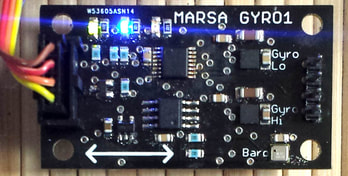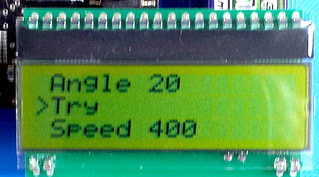Marsa Systems
Marsa Systems--
I've always been a huge fan of Marsa altimeters..
When they came out with the new 33L, that put them over the top..
Super tough, super accurate, super well made,,
ease of programming without having to be connected to a computer..
just a real high end unit, without the high end price tag..
Try a Marsa altimeter once, you'll be hooked for life..
The Marsa 33L HD--
Marsa Altimeter Comprehensive List of Features
I've always been a huge fan of Marsa altimeters..
When they came out with the new 33L, that put them over the top..
Super tough, super accurate, super well made,,
ease of programming without having to be connected to a computer..
just a real high end unit, without the high end price tag..
Try a Marsa altimeter once, you'll be hooked for life..
The Marsa 33L HD--
Marsa Altimeter Comprehensive List of Features
- Complete programmability without the need of a computer
- Four current limited and protected outputs
- Output current is measured during firing and controlled to 6A max
- Fully LiPo battery safe without regards to battery size (2S LiPo recommended)
- Apogee detection options
- Barometric only
- Accelerometer only
- Barometric OR Accelerometer which ever occurs first
- Kalman filter fusion of Barometric and Accelerometer inputs
- Adjustable delay in 0.1 second increments
- Main Altitude events
- Deployment altitude adjustable in 100ft increments
- Timer events
- Delay from Launch Detect
- Delay from Motor Burnout
- Altitude - time lockout for staging protection
- On-board Diagnostics
- Live barometric and sensor accelerometer readings
- Battery voltage
- Actual e-match resistance readings (diagnostics and for continuity check)
- Output FET test and test-LED's for each output channel
- Flight simulator to test and dry-run altimeter event programming
- Power on Self Test (POST) and Continuity testing
- All sensors tested for normal outputs
- Ematch resistance checked, POST will fail if resistance is too or too low (short circuit)
- POST will fail if battery voltage drops below 6.5V
- Output channel and channel programming checked for consistency.
- Post will FAIL if there is an ematch attached to channel with no events programmed
- Post will FAIL if there is no ematch connected to a programmed channel
- Audio and visual indicators
- Beeper with programmable frequency tone
- Connection for external LED
- On-board super bright Cree LED on Marsa33LHD
- Reliability and Robustness
- All flight critical components surface mounted
- 5V signal levels for greater RF interference and noise immunity
- Data
- Flight data storage for last 2 flights
- Motor thrust and impulse characterization analyzer within MarsaConnect (PC Windows only)
- Expandability
- Extend to 9 programmable with MarsaNet and remote Pyro Modules (MrfPyro)
- Future MarsaNet and other expandable modules in development
Marsa Gyro1 Tilt Module
The Marsa Gyro1 tilt module is the most advanced tilt measurement systems for rocket avionics currently available. It attaches to the Marsa 54L, 54LHD and 33LHD expansion header and provides rocket rotation data to the altimeter. Also the tilt module features a 100K barometric sensor which extends the Marsa altimeter's Kalman filter for better accuracy on those high altitude flight.
The Marsa Gyro1 tilt module is the most advanced tilt measurement systems for rocket avionics currently available. It attaches to the Marsa 54L, 54LHD and 33LHD expansion header and provides rocket rotation data to the altimeter. Also the tilt module features a 100K barometric sensor which extends the Marsa altimeter's Kalman filter for better accuracy on those high altitude flight.
Why 2 gyros?
Current altimeters with tilt capability that use a single gyro have a significant performance compromise. A rocket in flight can rotate about its 3 axes. These are spin, pitch and yaw. The latter 2 rotations are the ones that we are primarily interested in for staging applications. In a rocket flight the pitch and yaw rotations occurs at a slow rate (hopefully). However for a high altitude flight these very low rate rotations can add to a significant tilt angle for which we would want to inhibit a sustainer motor ignition.
The spin rotation is one we usually do not care too much about. In fact a decent spin rate can help to stabilize the rockets direction. The spin rotation rates can be very high compared to the pitch and yaw rates of the rocket. However you still need to measure this spin rate accurately to accurately calculate the attitude of the rocket. Devices that use a single gyro have to set the gyro sensitivity low to be able the measure the spin rate. As a result the accuracy and resolution suffers for the rates that are really important (yaw and pitch).
Marsa Systems solution is simple, one gyro set for the sensitivity to measure the spin and another gyro set up to accurately measure the low rotation rates of yaw and pitch.
When a Marsa Gyro1 is connected to the Marsa altimeter it is detected and tilt awareness is applied to any channels programmed for timer-motor events.
A global tilt parameter menu is used to program the tilt related constraints for the motor-timer event.
The first line sets the angle limit for the timer channel to fire.
The 3rd line sets a maximum speed limit for the staging event. This allows a flight profile that lets the rocket coast down to a predetermined speed before the channel fires.
The second line sets the condition for the speed constraint. The options are "Try", "Require" and "Ignore"
"Try" attempts to let the rocket coast down to the target speed but if the rocket is at the maximum tilt angle before the target speed is reached the channel will fire.
"Require" will not fire the channel until the target speed is reached AND the tilt angle is less than the allowable set angle.
"Ignore" ignores the speed parameter and fires the channel at the preset delay at the time delay programmed for the timer.
Current altimeters with tilt capability that use a single gyro have a significant performance compromise. A rocket in flight can rotate about its 3 axes. These are spin, pitch and yaw. The latter 2 rotations are the ones that we are primarily interested in for staging applications. In a rocket flight the pitch and yaw rotations occurs at a slow rate (hopefully). However for a high altitude flight these very low rate rotations can add to a significant tilt angle for which we would want to inhibit a sustainer motor ignition.
The spin rotation is one we usually do not care too much about. In fact a decent spin rate can help to stabilize the rockets direction. The spin rotation rates can be very high compared to the pitch and yaw rates of the rocket. However you still need to measure this spin rate accurately to accurately calculate the attitude of the rocket. Devices that use a single gyro have to set the gyro sensitivity low to be able the measure the spin rate. As a result the accuracy and resolution suffers for the rates that are really important (yaw and pitch).
Marsa Systems solution is simple, one gyro set for the sensitivity to measure the spin and another gyro set up to accurately measure the low rotation rates of yaw and pitch.
When a Marsa Gyro1 is connected to the Marsa altimeter it is detected and tilt awareness is applied to any channels programmed for timer-motor events.
A global tilt parameter menu is used to program the tilt related constraints for the motor-timer event.
The first line sets the angle limit for the timer channel to fire.
The 3rd line sets a maximum speed limit for the staging event. This allows a flight profile that lets the rocket coast down to a predetermined speed before the channel fires.
The second line sets the condition for the speed constraint. The options are "Try", "Require" and "Ignore"
"Try" attempts to let the rocket coast down to the target speed but if the rocket is at the maximum tilt angle before the target speed is reached the channel will fire.
"Require" will not fire the channel until the target speed is reached AND the tilt angle is less than the allowable set angle.
"Ignore" ignores the speed parameter and fires the channel at the preset delay at the time delay programmed for the timer.




